Step-by-Step Guide: How to Drill into Concrete Block

If you’re planning on hanging something on your concrete block walls, such as shelving or a television mount, you’ll need to drill into the block to securely anchor your hardware. While concrete block is a strong material, drilling into it requires a specific method to ensure success. This step-by-step guide will walk you through the process of drilling into concrete block, providing you with the knowledge and confidence to complete the task effectively.
Step 1: Gather the necessary tools and materials.
Before you begin, make sure you have all the required tools and materials. You’ll need a power drill with a masonry bit, safety glasses, gloves, a dust mask, a tape measure, a pencil, a level, a shop vacuum or brush, and concrete anchors.
Step 2: Choose the right drill bit and adjust your drill settings.
Concrete block requires a specially designed masonry bit to drill into it. Look for a masonry bit with a carbide or diamond tip, as they are specifically designed for drilling into concrete. Once you have the correct bit, adjust your drill settings to the hammer or percussion mode, as this will provide the necessary impact to penetrate the concrete block.
Step 3: Mark your drilling points.
Using a tape measure, carefully measure and mark the desired drilling points on the concrete block. Use a pencil to make small marks that can be easily wiped away later. Use a level to ensure your marks are straight and even.
Step 4: Start drilling.
Put on your safety glasses, gloves, and dust mask to protect yourself against any debris. Position the drill bit on the first marked point and hold the drill firmly. Apply steady pressure as you start drilling, maintaining a straight angle. Be patient and let the drill do the work, avoiding excessive force that could damage the bit or block. Keep drilling until you reach the desired depth, periodically removing the drill to remove accumulated dust and debris with a shop vacuum or brush.
Step 5: Install the concrete anchors.
Once you have drilled all the necessary holes, it’s time to install the concrete anchors. Choose anchors that are appropriate for the weight and size of the item you’re hanging. Insert the anchor into the hole, tapping it gently with a hammer to ensure it is secure. Repeat this process for all the holes.
Step 6: Attach your hardware.
With the concrete anchors in place, you can now attach your hardware to the concrete block. Use a screwdriver or drill to secure the hardware to the anchors, following the manufacturer’s instructions.
Remember to always wear protective gear when working with power tools and concrete. Take your time and work carefully to ensure a successful outcome. Now that you know the step-by-step process of drilling into concrete block, you can confidently tackle your next DIY project!
Gather the necessary tools
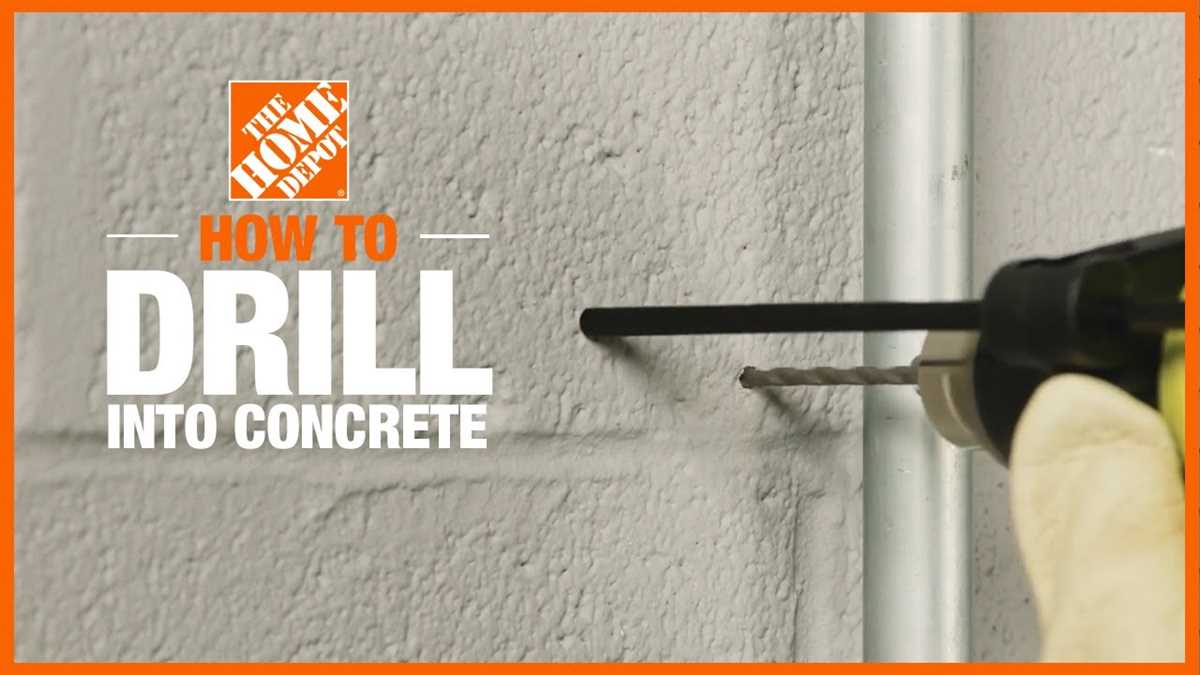
Before you start drilling into concrete block, it is important to gather all the necessary tools and equipment. Here is a list of the tools you will need:
- Hammer drill: This specialized drill is designed for drilling into hard materials like concrete block. Make sure you have a good quality hammer drill that is capable of drilling through concrete.
- Masonry drill bits: These drill bits are specifically designed for drilling into masonry materials, such as concrete block. They have a carbide tip that is capable of cutting through the hard surface of the concrete.
- Safety goggles: Concrete drilling can produce flying debris, so it is important to protect your eyes with safety goggles.
- Dust mask: Drilling into concrete can also create a lot of dust, so wearing a dust mask is recommended to protect your lungs from inhaling the dust.
- Tape measure: You will need a tape measure to measure the location and depth of the holes you need to drill.
- Marker or pencil: Use a marker or pencil to mark the locations on the concrete block where you need to drill.
- Extension cord (if necessary): Depending on the location of the drill and the availability of power outlets, you may need an extension cord to ensure you have enough length to reach the drilling location.
- Vacuum cleaner or brush: After drilling, you will need to clean up the dust and debris. A vacuum cleaner or brush can help you clean the drilled holes and surrounding area.
- Safety gloves: Concrete drilling can be a physically demanding task, so wearing safety gloves can provide you with better grip and protection.
Make sure you have all these tools ready before you start drilling into concrete block. Having the right tools will make the drilling process easier and safer.
Mark the drilling spot
Before you start drilling, it is important to accurately mark the spot where you want the hole to be. This will ensure that you drill in the right place and avoid any damage to the surrounding area.
Here are some steps to follow when marking the drilling spot:
- Measure and mark the desired location on the concrete block using a tape measure or ruler. Use a pencil or permanent marker to make a clear and visible mark.
- If drilling multiple holes, use a level or straight edge to ensure that the marks are aligned and in the correct position. This will help you maintain accuracy and consistency.
- If drilling into an exterior wall, consider using a stud finder to locate any vertical framing members behind the concrete block. This can help you avoid drilling in a load-bearing area.
- If drilling into a horizontal surface, such as a concrete block floor or ceiling, be aware of any electrical or plumbing lines that may be hidden within the concrete. Use caution to avoid damaging these utilities.
By taking the time to properly mark the drilling spot, you can ensure that your holes are placed exactly where you want them and avoid any unwanted complications during the drilling process.
Put on safety gear
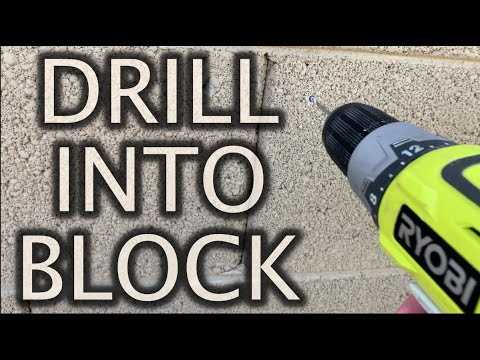
Before drilling into concrete blocks, it is important to prioritize your safety by wearing the appropriate gear. This will help protect you from potential hazards and injuries. Here are some safety gear items that you should wear:
- Safety goggles: Protect your eyes from flying debris or dust particles.
- Dust mask: Prevent the inhalation of dust and other harmful particles.
- Ear defenders: Minimize the noise from the drilling process and protect your ears.
- Gloves: Shield your hands from any sharp or abrasive surfaces.
- Protective clothing: Wear long sleeves and long pants to protect your skin from scratches or chemicals.
- Steel-toed boots: Provide extra protection for your feet in case heavy objects fall.
Putting on safety gear is an essential step to ensure your well-being while drilling into concrete blocks. Remember to always prioritize safety and follow proper precautions.
Choose the right drill bit
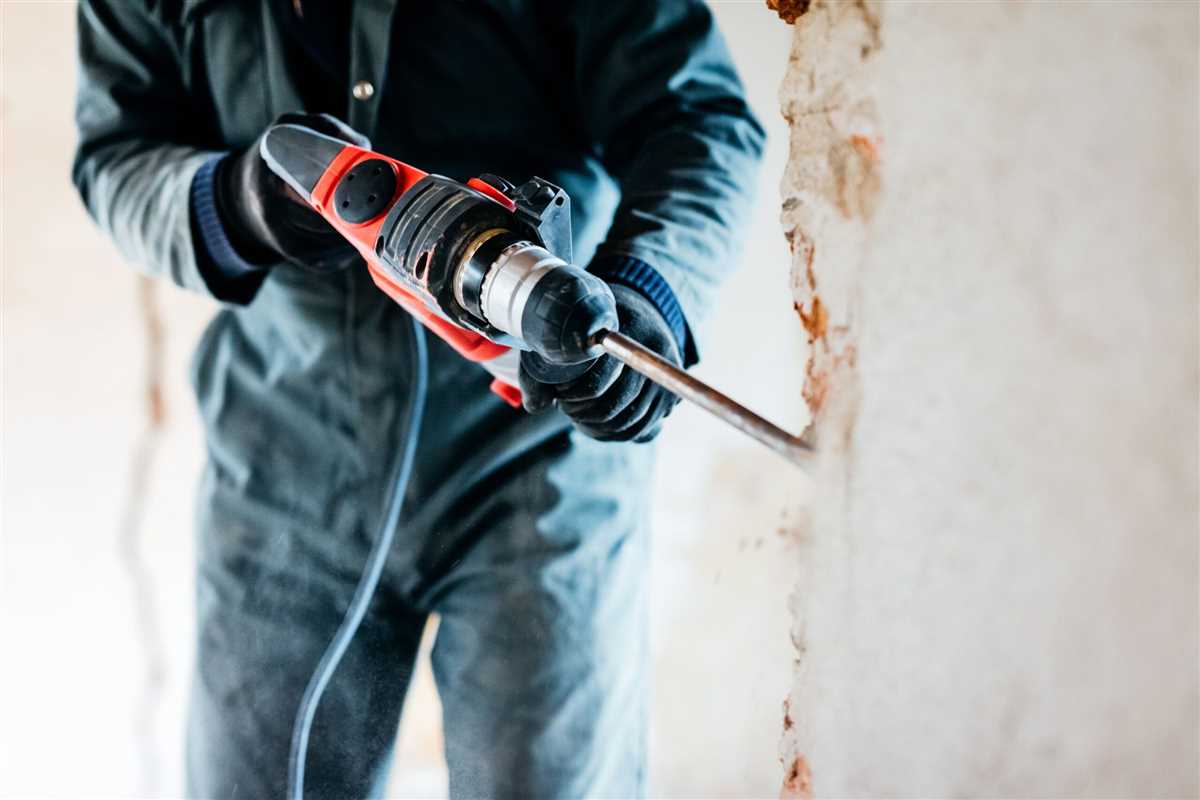
Choosing the correct drill bit is crucial when drilling into concrete block. The type of drill bit you use will depend on the size and type of hole you need to create.
1. Masonry drill bits
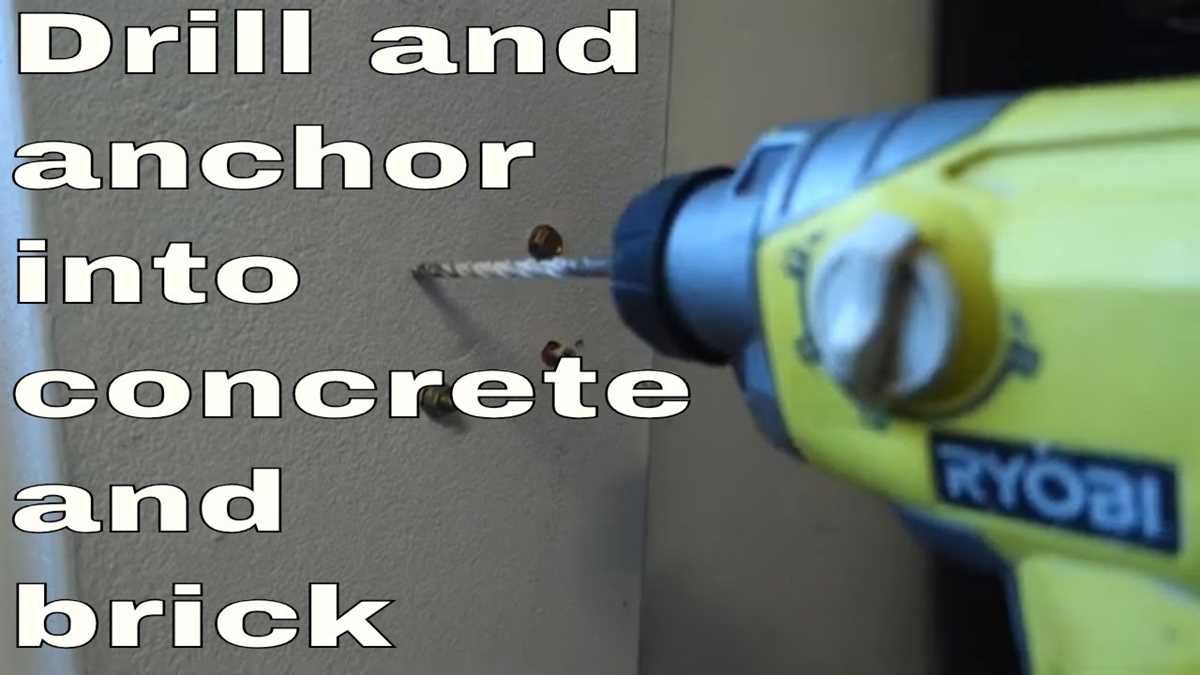
Masonry drill bits are the most common type of drill bits used for drilling into concrete block. These bits are specifically designed to handle the tough and dense nature of concrete. They feature a carbide or diamond tip that can easily penetrate the material and create a clean and precise hole.
When selecting a masonry drill bit, make sure to choose one that is the appropriate size for the hole you need. It’s also important to check the compatibility of the drill bit with your drill, as some may require a specific chuck size or type.
2. Hammer drill bits
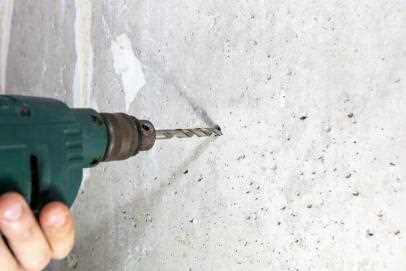
If you’re using a hammer drill (which is recommended for drilling into concrete block), you may want to consider using hammer drill bits. These drill bits have a special tip that helps break up the concrete as you drill, making the process faster and easier.
Hammer drill bits are available in various sizes and types, just like masonry drill bits. Make sure to choose the right size and type of hammer drill bit based on your specific drilling needs.
3. Carbide-tipped drill bits
Carbide-tipped drill bits are another option for drilling into concrete block. These bits are similar to masonry drill bits, but they have a carbide tip that provides extra durability and longevity.
Carbide-tipped drill bits are known for their ability to withstand high heat and pressure, which makes them ideal for drilling into tough materials like concrete. They are available in a variety of sizes and can be used with both regular and hammer drills.
4. Diamond drill bits
If you require larger or more precise holes in concrete block, diamond drill bits are a great choice. These drill bits are made with a diamond coating that allows them to cut through hard materials with ease.
Diamond drill bits are commonly used for drilling holes in tiles, stones, and concrete. They come in various sizes and can be used with both regular and hammer drills, depending on the size and depth of the hole you need.
When choosing a diamond drill bit, consider the type of concrete block you’re drilling into and select a bit that is compatible with the material.
It’s essential to select the right drill bit for the job to ensure efficiency, precision, and safety. Using the wrong drill bit can lead to ineffective drilling, damage to the drill bit, and potential injury. Always refer to the manufacturer’s instructions and guidelines when selecting and using drill bits.
Set up the drill
Before you start drilling into the concrete block, you’ll need to set up your drill properly. Here are the steps to follow:
- Select the right drill bit: Choose a masonry drill bit that is suitable for drilling into concrete. Make sure the diameter of the drill bit matches the size of anchor or screw you’ll be using.
- Secure the drill bit: Insert the selected drill bit into the chuck of your drill. Tighten the chuck to hold the drill bit securely in place.
- Put on safety gear: Before drilling, make sure you are wearing appropriate safety gear, such as safety glasses and ear protection.
- Adjust the drill settings: Set the drill to the recommended speed and torque for masonry drilling. This will help you achieve better results and prevent overheating or damage to the drill.
- Secure the concrete block: If the concrete block is not already installed, make sure it is securely positioned or clamped down to prevent it from moving while you drill.
Once you have set up your drill, you’re ready to move on to the next step in the drilling process.
Start drilling into the concrete block
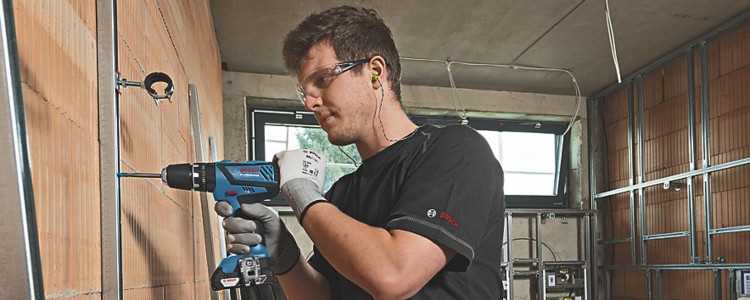
Before you start drilling into the concrete block, make sure you have all the necessary tools and safety equipment. You will need:
- Hammer drill
- Masonry drill bit
- Masonry anchors
- Safety goggles
- Ear protection
- Dust mask
Once you have gathered the necessary tools, follow these steps to start drilling into the concrete block:
- Mark the drilling location: Use a pencil or marker to mark the exact spot where you want to drill. Double-check the position and make sure it is level.
- Secure the concrete block: If the concrete block is not securely mounted, use clamps or a vice to hold it in place. This will prevent it from moving or cracking during drilling.
- Put on safety equipment: Put on your safety goggles, ear protection, and dust mask to protect yourself from flying debris and noise.
- Choose the correct drill bit: Select a masonry drill bit that matches the diameter of the hole you want to create. Masonry drill bits are specifically designed for drilling into concrete and other masonry materials.
- Set the drill to hammer mode: Most hammer drills have a switch that allows you to choose between regular drilling mode and hammer mode. Switch to the hammer mode to create a hammering action that will help break through the concrete.
- Create a guide hole: Start by drilling a small guide hole at a slow speed. This will help prevent the drill bit from wandering and will make it easier to drill the larger hole.
- Drill the hole: Once the guide hole is created, gradually increase the speed and apply steady, firm pressure as you drill into the concrete block. Use a circular motion to help remove the dust and debris from the hole.
- Clean out the hole: Occasionally stop drilling and remove any dust or debris from the hole using a vacuum or a brush. This will help ensure that the hole is clean and free of obstructions.
Following these steps will help you safely and effectively drill into the concrete block. Remember to take breaks if needed and be patient, as drilling into concrete can require some time and effort.
Use a vacuum or brush to remove dust
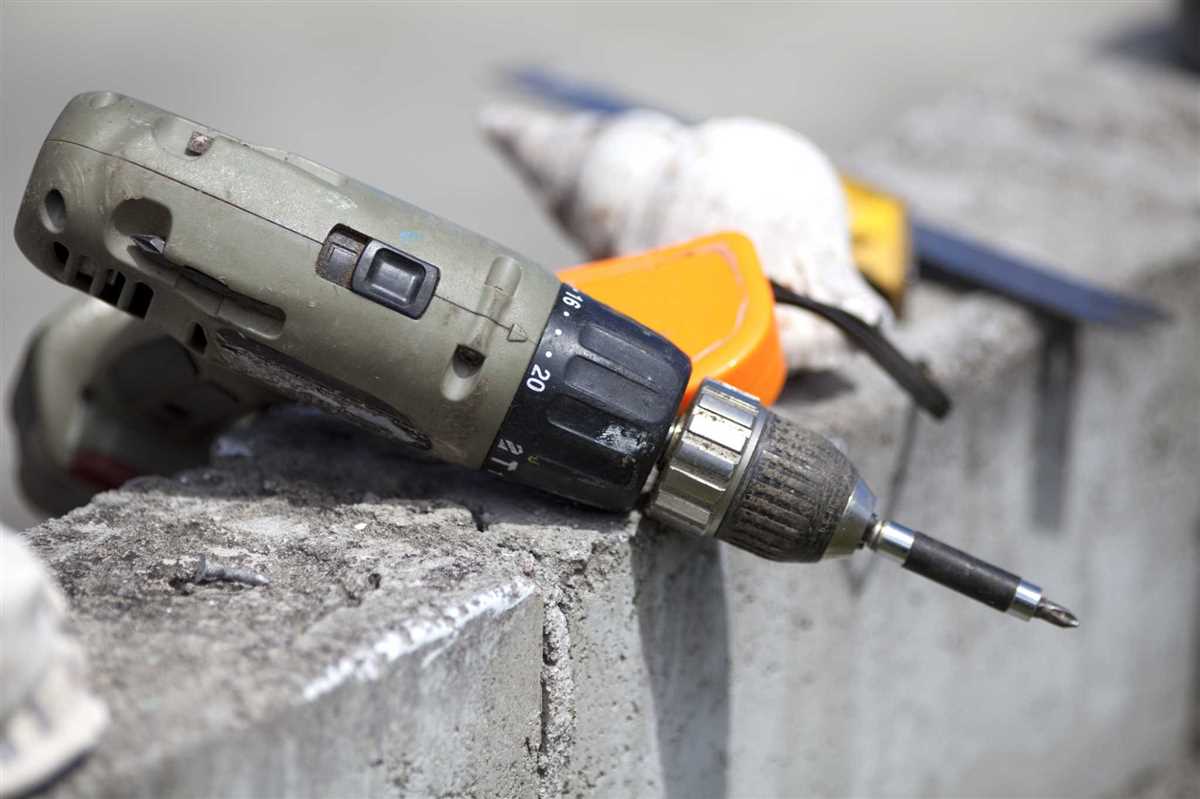
After drilling into the concrete block, it is important to clean up any dust or debris that has been created. This will not only help to maintain a clean working area, but it will also enhance the effectiveness of your drilling, as accumulated dust can hinder the performance of your tools. To remove dust, you can use a vacuum cleaner with a hose attachment or a brush specifically designed for this purpose.
Here are the steps to follow:
- Attach the hose attachment to the vacuum cleaner or select a suitable brush.
- Hold the hose or brush close to the drilled hole to collect the dust as it is being removed.
- Move the vacuum cleaner or brush around the area to ensure that all dust and debris are adequately gathered.
- Continue vacuuming or brushing until no visible dust remains.
- Dispose of the collected dust properly according to local regulations. It is essential to take proper safety precautions when handling or disposing of any potentially hazardous materials.
By cleaning up the dust, you will create a cleaner and safer working environment and ensure that the hole is free from any obstructions that may affect further drilling or installation processes.
Finish and clean up
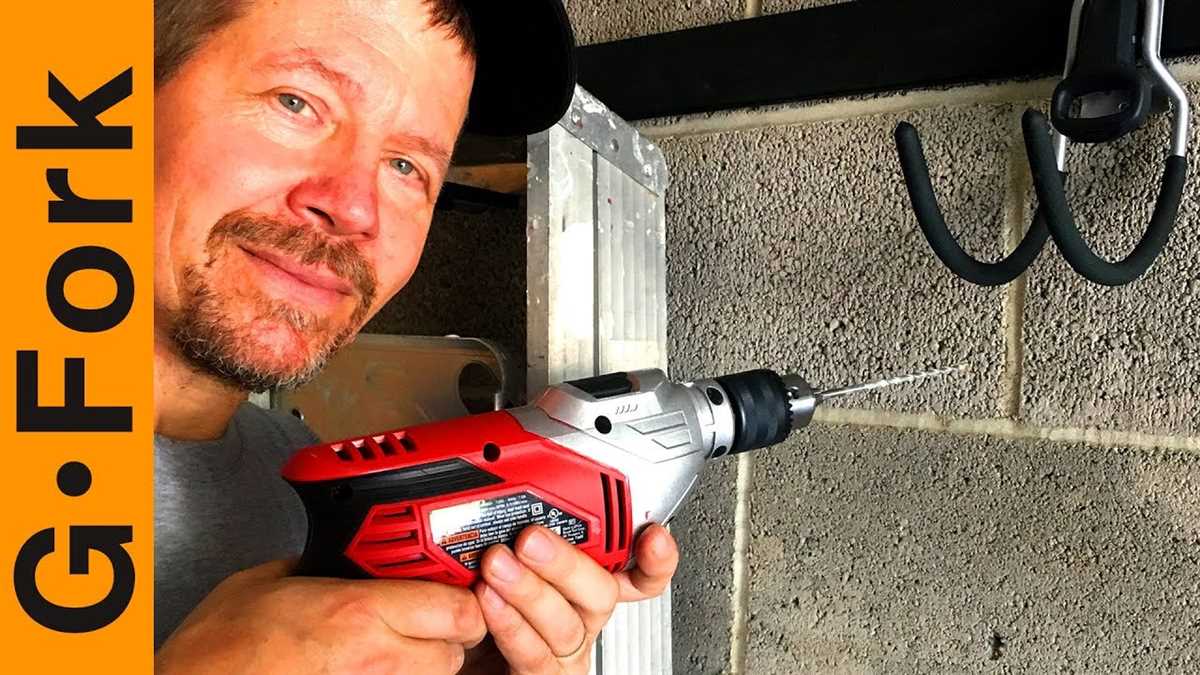
After you have successfully drilled into the concrete block, it is important to finish the task properly and clean up the area.
- Remove the dust: Use a brush or a vacuum cleaner to remove any dust or debris that may have accumulated around the drilled hole. This will ensure a clean surface for any further work or installations.
- Inspect the hole: Take a closer look at the drilled hole to ensure that it is clean, smooth, and free from any loose concrete or debris. If necessary, use a wire brush or a small chisel to remove any remaining material.
- Dispose of waste: Place any waste material, such as concrete dust or debris, in a suitable container for disposal. Make sure to follow local regulations and guidelines for proper waste disposal.
- Seal the hole: If desired, you can seal the hole with an appropriate concrete sealer or filler. This can help prevent moisture and dust from entering the hole and can also improve the overall appearance.
Remember to always wear protective gear, such as safety goggles and a dust mask, when drilling into concrete to ensure your safety. Additionally, be cautious when handling power tools and follow the manufacturer’s instructions for proper use and maintenance.
FAQ:
What tools do I need to drill into a concrete block?
To drill into a concrete block, you will need a hammer drill, masonry drill bits, safety goggles, a dust mask, ear protection, and a vacuum cleaner for cleaning up the dust.
What type of drill bit should I use for drilling into a concrete block?
When drilling into a concrete block, it is recommended to use a masonry drill bit that is specifically designed for drilling into concrete. These drill bits have a carbide tip that is able to handle the tough nature of the concrete.
How should I prepare the area before drilling into the concrete block?
Before drilling into the concrete block, it is important to mark the drilling location with a pencil or a marker. Then, you should put on your safety goggles, dust mask, and ear protection to protect yourself from the dust and noise. Finally, you can use a vacuum cleaner to clean the area and remove any loose debris.
What technique should I use when drilling into a concrete block?
When drilling into a concrete block, it is best to start with a small pilot hole to guide the drill bit. You should use a slow drilling speed and apply steady pressure to prevent the drill from bouncing. It is also important to periodically remove the drill bit from the hole to clear away the dust and prevent overheating.
Video:













